
Updated 18 August 2016

|
Updated 18 August 2016 |
|
HOME PAGES GLOBAL WARMING WHAT YOU CAN DO GREEN ISSUES BACKGROUND THE INITIATIVE |
Reducing Greenhouse Gas Emissions by Replacing Coal, Oil and Gas This page summarises the possibilities for generating energy using renewable resources to replace burning of fossil fuels. Large-scale generation and small-scale generation are covered, as well as nuclear fusion. Related issues are how to transport solar energy over long distances from the tropics, how to deal with and store energy from intermittent renewable sources for when it is needed, and carbon dioxide capture and storage. The controversial, complex and very current issues around nuclear fission power are covered on a separate page, as is the use of hydrogen as a fuel. There is also a separate, short note on the cost of offshore wind energy. There are numerous sources of basic information. A good general introduction to the different energy sources in the Alternative Energy Resources website created by Andy Darvill, science teacher at Broadoak Community School, Weston-super-Mare, England. The Wikipedia provides a thorough and more formal overview, as well as full detail on the various technologies. A stimulating, realistic and provocative view by Cambridge physicist David MacKay is presented in his book Sustainable Energy – without the hot air, available free for downloading or on paper in bookshops. There are more suggestions on our links page. 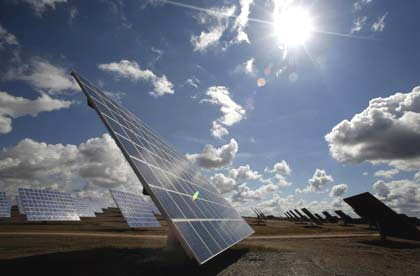
The amount of solar energy available is enormous. Every hour enough energy arrives at the Earth to meet our current energy demands for a whole year. Simple but effective applications use solar energy as it arrives. For example, it can be focused onto a container to heat water, it can stream through windows to heat buildings and greenhouses, or it can provide hot water by heating solar thermal panels on roofs. The two main methods of converting solar energy to electricity are either concentrated solar power, to focus sunlight onto a boiler and create high-temperature steam which can drive a turbine, or to convert it directly into electricity using arrays of solar photovoltaic cells. Less direct uses of solar energy extract the energy after it has been converted into wind or waves, or after it has raised water into the atmosphere to be dropped as rain and then to drive hydroelectric schemes. Biomass schemes or biofuels use either agricultural waste or plants grown for the purpose, either directly or by burning fuels produced from them. This is in principle renewable, as the carbon dioxide produced in burning the fuel was taken from the atmosphere as the plants grew. Two other sources of renewable energy do not depend on the heat arriving from the sun. Tidal energy arises from the gravitational attraction of the moon and sun. It can be extracted most easily by taking energy from tidal flows into and out of estuaries. Geothermal energy uses the hot interior of the Earth as a source. Matching the load and energy storage Discussions of electricity generation from renewable sources sometimes neglect the need to match availability to demand. Some of the sources discussed below have obvious limitations – solar power can only be generated during daylight hours and varies with the weather, tidal power depends on tidal flow, wind power isn't available in still weather, etc. A substantial fraction of electricity generated has to be available according to demand. One way to help with this is the use of stored-power schemes, such as exist in Wales and Scotland, but these have limited capacity. It is therefore important to develop new and efficient ways to store energy, to make it available when required. The need to supply a constant base load is also one of the arguments advanced in favour of building new nuclear fission power stations, discussed on a separate page. Energy storage is also important for portability. When we drive in a car or bus, or fly in a plane, we carry the energy source with us in the form of fossil fuel. In order to utilise renewable energy sources, we have to develop efficient, affordable ways to store energy. Will this be in the form of batteries charged by mains electricity, or energy stored as hydrogen (separate page) and either being burned or used to power fuel cells? There are a lot of possibilities, but in all cases there are problems that must be overcome by further research and development. 
Large-Scale Renewable Energy Generation In this section we discuss various possible sources that can be used for generating electricity in large, centralised installations. We also touch on large-scale production of replacements for petrol and diesel as motor fuel. Sources already in use Hydroelectric power comes from the potential energy of dammed water (e.g. Hoover Dam in the US at right), and is the most widely used and well-established form of renewable energy. It uses no fuel, produces no waste, and does not generate carbon dioxide. It is very economic in appropriate cases. However, many schemes are controversial. Construction costs can be high, there is inevitably damage (often severe) to the environment, large numbers of people may be displaced, and silting-up can limit the useful lifetime. 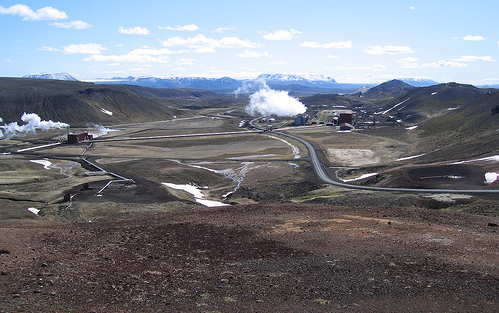
Nuclear power using fission is an established form of electricity generation. As it is very controversial for a number of reasons, it is discussed separately on its own page. Geothermal energy comes from heat stored beneath the Earth's surface. It uses no fuel, produces no waste, and does not generate carbon dioxide. In addition, geothermal power plants work all the time and are unaffected by changing weather conditions. It is cost-effective where it is easily available, as in Iceland where it produces 10% of electricity and heats 87% of homes, New Zealand and California. The photo shows the Krafla power station in Iceland. The main disadvantage is that the circulating fluid is at a relatively low temperature compared to steam from boilers, which limits the efficiency for generating electricity. It is therefore best used locally for low-temperature heat, such as greenhouses, district heating, etc. Wind power from large propeller-driven turbines is now a well-established technology, and the least expensive of the remaining list of technologies for renewable electricity generation. It uses no fuel, produces no waste, and does not generate carbon dioxide. Wind power is expanding rapidly, and generates more than 3% of total electricity world-wide. The country with the most installed (see table below) is now China, followed by the USA and German; the UK is sixth but leads the world in offshore wind power. 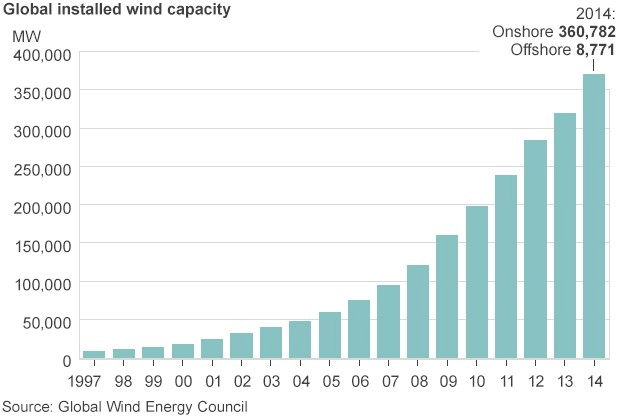
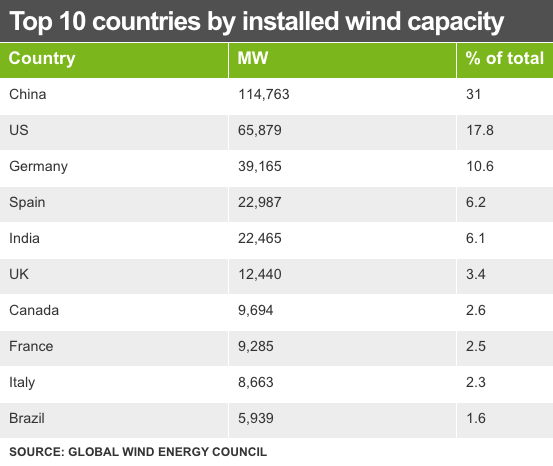
The country with the largest fraction of its electricity generation from wind is Denmark, at 30%, followed by Portugal and Spain at about 20%; the UK gets about 9%. Of course wind does not always generate full power – typical wind turbines cumulatively deliver about 30% of their peak rating. Onshore wind's costs have become roughly comparable to fossil fuel generation, with higher capital costs and lower generating costs. Subsidies and favourable treatment have encouraged its growth. However, wind is not always available so using it to generate much more than 20% of the required peak power brings diminishing returns because it needs to be backed up by other methods. The need for good and consistent wind conditions, and the environmental unpopularity of wind turbines in scenic regions, has led to the biggest wind farms increasingly being built offshore in Europe (most notably in the UK), and this demands larger-capacity turbines and much better reliability. The main problem that offshore wind must overcome is its higher cost compared to onshore wind power. We have a separate, short note on the cost of offshore wind. 
Biomass for biofuels as a source of energy has a long history. Humans have used wood fires from prehistoric times. Using biomass to produce motor fuel from sugar cane or maize is well established – for example, Brazil meets a significant proportion of its requirements with ethanol generated from sugar cane (photo). See our alternative road fuels page for more information. The US has introduced subsidised production of both biodiesel and ethanol. This has encouraged farmers to switch to maize from other crops, and roughly half of the huge US maize crop is now used to make ethanol rather than food. This has contributed to sharp rises in food prices world-wide. In Europe, production of biodiesel is being encouraged by requiring a small percentage to be added to all fuel on sale, using rapeseed or palm oil as a source. Again, this seems to be causing unpredicted knock-on effects on food production and prices. There are also other question marks over biofuel production. A lifetime analysis of the production cycle raises doubts about whether producing ethanol or biodiesel really reduces carbon dioxide emissions. And if the land used to grow biofuels is cleared forest, that too contributes to global warming. Finally, a recent paper reports that using biodiesel from maize or rapeseed generates significantly more nitrogen dioxide than had been assumed. As nitrogen dioxide is a much more potent greenhouse gas than carbon dioxide, the effect on global warming is calculated to be greater than from the use of fossil fuels. Where crops are grown solely for the purpose of converting solar energy into fuel, the efficiency of conversion is typically about 0.5% so a large area of land is needed. Increasing the use of biofuels is likely to put more pressure on vulnerable natural habitats such as forests, and lead to an undesirable growth in the use of artificial fertilisers. More recent proposals are to use waste material from food growing, or to use plants normally classified as weeds and to grow them on otherwise unproductive land. However, this requires progress in conversion to biofuels, especially for ethanol as it would be mainly cellulose rather than sugar and starch that must be converted. Future possibilities The other large-scale methods of producing energy are not yet making really significant contributions, or are at the prototyping stage, and in some cases are no more than ideas. 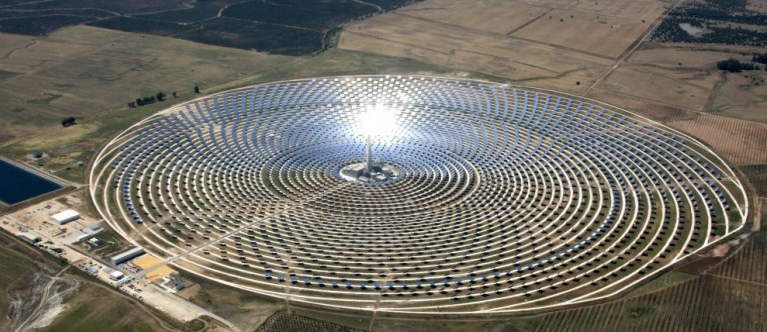
Solar energy can be used to generate electricity directly. However, this is not available during hours of darkness, and in climates like the UK's the output is also reduced in grey and rainy weather as well as in winter. To obtain a higher and more reliable yield, there are beginning to be grandiose schemes to cover large areas of desert (the Sahara in the case of Europe) with solar power generators. The Desertec initiative for Europe is described below. One technique is concentrated solar power (CSP), for example by focusing sunlight on a collector in which a fluid is heated and the resulting steam passed through a turbine. This is likely to become economic if fuel costs increase. The focusing elements are movable reflectors that follow the sun throughout the day, focusing for example on the tower pictured at right. A number of systems are already running or proposed, most notably in the southwestern United States and Spain. Although Spain missed its short-term target to generate 2.2–2.5 gigawatts (almost 5% of total consumption) with CSP by 2011, as of January 2014 Spain had a total capacity of 2.2 gigawatts making this country the world leader in CSP. In some versions, the sunlight heats molten salts instead of using water to produce steam directly. These can then be stored in insulated containers for some hours, allowing energy to be produced during the night or on cloudy days. The ability to store the heated medium means that CSP could be useful in smoothing out the intermittent electricity production of wind and solar photovoltaic panels and thus provide baseload power. Such a system, near Seville, is called Gemasolar (photo above). Its 2650 heliostats, covering 185 hectares, aim at a tower receiver 140 metres high; the heated molten salt is stored in two insulated tanks. It produces 20 megawatts and can run for 24 hours a day in summer and about three-quarters of full time averaged over a year, producing a total of about 110 gigawatt-hours per year. A larger CSP system with heat storage, producing 280 megawatts and a total of about 900 gigawatt-hours per year, was completed in Arizona, USA in 2013. Instead of focusing the sunlight on a tower, Solana has parabolic mirrors arranged to form troughs that focus the light on tubes carrying oil which is heated to 400°C. The hot oil is used to generate steam for electricity production, as well as heating tanks filled with molten salt to store the energy for up to 6 hours. 
The alternative of direct conversion to electricity by solar photovoltaic cells is also being developed in a number of places, with outputs up to tens of megawatts. This method (photo at left) is probably less likely to be successful for large-scale power generation on cost grounds unless the cost of the cells can be reduced dramatically. One way around this is again to use reflectors to concentrate more light on the photovoltaic cells. Cells optimised for this purpose would probably be very different from the ones currently in use. However, in the meantime greatly increased numbers of photovoltaic panel installations, encouraged especially in Europe by feed-in tariffs, have led to a substantial price reductions. At the end of 2012 the world-wide installed peak capacity was 100 gigawatts (GW), up by 42% on 2011. This was led by Germany with 33 GW, followed by Italy with 17 GW, and China and the US each with 8 GW. The UK had 1.8 GW. A third and more speculative method for large-scale solar energy generation would use a very tall chimney with its base surrounded over a wide radius with a transparent roof. The air under the roof is heated and drawn to and up the chimney. Energy is extracted by turbines at the base of the chimney, while much of the space under the roof could be used for agriculture. The energy available increases exponentially with the height of the chimney. A prototype system in Spain generated 50 kilowatts. A single solar-tower power plant with a collector area 7 km in diameter and a chimney 1 km high, built and operated in an area with high annual solar radiation, might generate between 700,000 and 800,000 megawatt-hours per year. Thus a small number of solar-tower power plants might even replace a large nuclear power station. However, as with all solar powered systems the energy supply is only available during the day. The possibility of generating solar electricity in tropical deserts in order to get maximum benefit from the sunlight requires a way to transport the energy over long distances. This is discussed below. Biomass for generating electricity using plants grown for this purpose requires large areas of land for limited energy production, and is labour intensive. However, by using sugar cane fibre, urban wood waste and similar things the US currently generates about 1.5% of its electricity from biomass. Hydrogen as a fuel, notably for motor vehicles, is much talked about and has potential, but is not yet in significant use and there are many problems to overcome. It is discussed in more details on our hydrogen and fuel cells page. Tidal energy is another form of hydroelectricity, and could be attractive in appropriate locations. There are two forms: tidal barrages have been around for many years, while tidal streams are more recent. 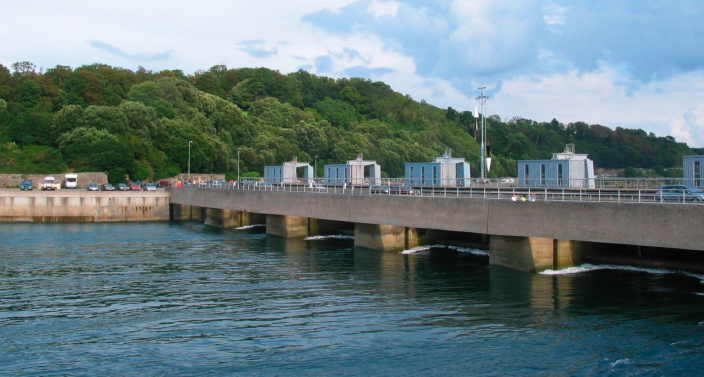
Tidal barrages are in operation at a few locations world-wide. The first and by far the biggest is the Barrage de la Rance, which spans the estuary of the River Rance near St-Malo, France. It was completed in 1966, takes advantage of some of the highest tides in the world (up to 13.5 metres), and generates 240 megawatts peak – it is shown at right. A 254 megawatt project, the Sihwa Lake Tidal Power Station in South Korea, is due to surpass it in 2010. It is estimated that tidal schemes in selected places around the UK could generate up to 20% of the current UK electricity demand. Barrages work by damming estuaries, with the tidal flow turning turbines as it enters and leaves. However, the dams interfere with shipping and damage the ecosystem. The energy is intermittent, but schemes in different locations with tides 3 hours apart could complement each other. Capital costs are high but running costs are low. The recently revived Severn barrier scheme, for example, is a huge project which would cost perhaps £15 billion and generate perhaps 5% of the UK's electricity. Despite its green intention there is strong opposition, not least by environmental groups. Tidal streams can generate energy without requiring dams. Rotors or similar devices are installed where islands or other constrictions generate fast tidal flows. There have been several successful trials, and there are now proposals to build deep-sea tidal-energy farms. In terms of output these are similar to wind farms, with each turbine generating about 1 megawatt peak. 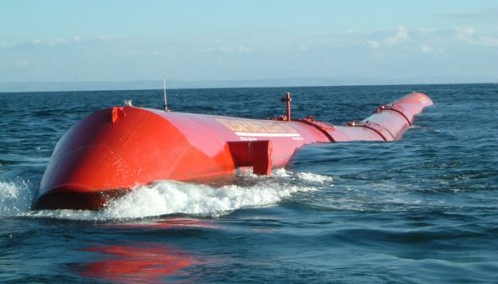
Wave power uses the up-and-down motion of water caused by waves to generate electricity. Trials of various types of devices have been going on for years, but it is only now that the world's first commercial wave farm, based in Portugal and utilising three 750 kilowatt Pelamis devices (picture at left), is being tested. Efficiently converting the irregular motion of waves into a reliable source of power is challenging, and building reliable devices which will survive storms and saltwater corrosion is not easy. Geothermal energy ("hot rocks") to generate electricity in non-volcanic areas, using the heat of rocks deep below the Earth's surface, is being looked into, notably in Australia. Ocean currents could in principle be a major source of energy. The Gulf Stream moves at 4 km per hour in some places, and a turbine anchored in it could generate continuous power. However there are obvious difficulties in getting the energy ashore. Ocean thermal energy uses the fact that deep ocean temperatures are lower than surface temperatures. Unfortunately, the energy that can be generated from the relatively small temperature difference is probably too low to be viable. Small-Scale Renewable Energy Generation In this section we mention smaller-scale systems that could be used for generating electricity and heating. These options are discussed in more detail on our domestic renewable energy page. In addition, our domestic grants page has up-to-date information on the Feed-In Tariff for renewable electricity and the Renewable Heat Incentive for heat and hot water – these make such systems much more viable financially. For electricity generation these systems are deployed in large numbers and connected to the electricity grid, replacing electricity from large central power stations and eliminating much of the energy waste incurred by long-distance distribution over power cables. Large-scale microgeneration would cause a major change in the economics of electricity generation. A significant issue where small, variable quantities of electricity are generated locally is how the owner is rewarded for the electricity generated. Germany, and then other countries including Spain and Portugal, introduced feed-in tariffs that initially pay much more than the real price for electricity exported to the grid, in addition to the savings made because some of the generated electricity is consumed locally in place of electricity from the grid. This has encouraged many people to install these systems, which should lower their cost via large-scale production and innovations in the technologies. As the cost of microgeneration systems comes down, the feed-in tariff is reduced accordingly. In the UK the initial approach was to subsidise installation with government grants, but the system was not generous or well focused. This has changed dramatically with the new arrangements mentioned above. The UK Feed-In Tariff scheme is unusual in rewarding all generation, whether used locally or exported, though exports attract a somewhat higher return. The tariff was initially set quite generously, and take-up of solar photovoltaic panels in particular exceeded expectations. As a result, the tariff was hugely reduced. Although solar panel prices have also come down a great deal, the reduction in the full cost of a system has not come down as much as the tariff. The UK's Renewable Heat Incentive claims to be a world first. The scheme is designed to reward a wide range of renewable systems for heating and hot water over their the first seven years of their lifetime. 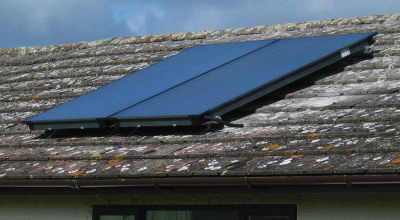
Solar thermal panels for water heating (photo at right) are reasonably competitive when installed in suitable buildings, more so for heating water by electricity rather than gas,. They are a relatively simple and reliable technology. In the UK they can typically heat up to about 60% of the annual requirement for hot water, but of course do even better in sunnier and warmer climates. The country with the largest number of installations is China, while 90% of houses in Israel have solar hot water systems. 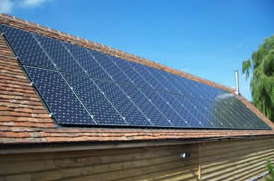
Solar photovoltaic cells are widely used for powering installations such as motorway telephones and road signs, where they save the cost of cabling mains electricity. Although expensive for domestic installations (photo at left), the cost has come down substantially with improved technology and increased production – they have become a common sight in the UK. At present solar cells are made from silicon wafers, but cheaper alternatives are being researched and developed. There is a trade-off between efficiency and cost, and working lifetime is also a concern for some of the possibilities. These newer types are currently less efficient than the 14–19% conversion of solar energy into electricity achieved by commercial silicon solar cells, but they should be significantly cheaper. The alternatives include thin-film devices using either silicon, electrically conductive plastics, a cell using phthalocyanine dye to mimic the action of chlorophyll, and more exotic ideas using nanoparticles. Both photographs above are of systems installed in Blewbury. Wind turbines in relatively small sizes can be useful to reduce requirements for mains electricity, particularly in isolated locations. For most UK domestic situations the average wind speed is not sufficient to justify their cost, and there can be structural problems if they are installed on houses. Ground-source heat pumps to heat buildings use the heat in the ground a short distance below the surface (due mainly to solar energy) as a source to drive a heat pump that works like a refrigerator in reverse. To gather the energy a pipe must either be buried under a large area of land, or placed in a deep, drilled hole. 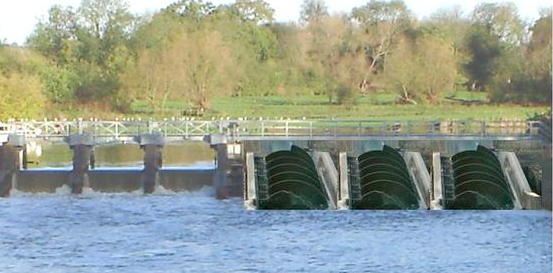
Air-source heat pumps are also like reversed refrigerators or air conditioners, and are simpler than ground-source heat pumps because they do not need underground pipes. The key figure of merit for both kinds of heat pumps is the ratio of heat energy produced to electricity consumed. Combined heat and power (CHP) uses some of the heat produced by a central heating boiler to generate electricity rather than wasting it. Using fossil fuel the overall efficiency is higher than normal central heating. However, it is only renewable if the fuel is renewable, for example wood pellets. Small water turbines are being installed in many places where suitable. Near Blewbury there are three projects on the River Thames: at Osney Lock in Oxford (operational), Sandford Lock (approved) and Goring-on-Thames (planned; picture at right, but locals don’t all approve). The project for Abingdon has unfortunately had to be cancelled due to reductions in support. There is more information on the basics of small-scale hydro possibilities in general and these projects in particular on our domestic generation page. 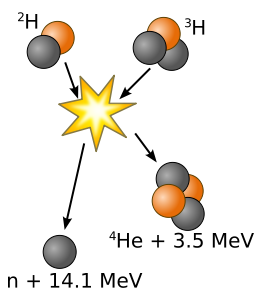
The basic concept of fusion reactions is to force two atoms of light elements, such as hydrogen, helium or boron, close enough together so that the strong nuclear force in their nuclei will pull them together into one larger atom. The resulting nucleus will have a slightly smaller mass than the sum of their original masses. The difference in mass is released as energy, according to Einstein's famous mass-energy equivalence formula E = mc2. Fusion is the power source of the sun and all the stars. It is also the reaction used for the hydrogen bomb, in which the fusion is triggered by a nuclear fission explosion. The goal is to produce fusion reactions in a controlled way that can replace burning of fossil fuels, and that is potentially much safer and cleaner than the nuclear fission reactions used in current nuclear power stations. The favoured atoms are usually the heavier isotopes of hydrogen, deuterium and tritium, which have one proton and either two or three neutrons in their nuclei, respectively. For example, fusing deuterium with tritium produces a helium nucleus and a neutron, plus energy, as shown in the figure. Deuterium can be extracted from water, while tritium can be produced by adding lithium to the fusion device. (More details are in the Wikipedia.) An alternative is to fuse two deuterium nuclei, though this requires more exacting operating conditions. The amount of power that could be generated by a fusion reaction is potentially much greater than that available from nuclear fission. Magnetic confinement The currently favoured approach is to use machines that confine the materials in the form of a very hot plasma, using a magnetic field. (A plasma is a gas so hot that its atoms have separated into electrons and atomic nuclei.) The currently favoured configuration is a doughnut-shaped (toroidal) chamber called a Tokomak. The problem is how to heat a plasma up to about 100 million degrees, and to maintain the temperature and confine the plasma for long enough to produce useful energy. 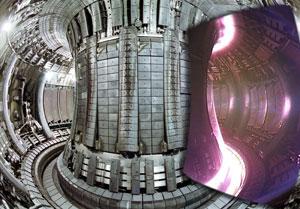
Current status: Experimentation and progress continues, but even after half a century of research fusion reactors are a prospect only in the long term. The Joint European Torus (JET) located in Culham, Oxfordshire, can produce energy – it has generated 16 megawatts for nearly a second, which approaches the energy it needed to run (so-called break-even). The inside of JET is shown at left, with the purple an artist's impression of the plasma. In 2005 there was international agreement (including the UK) to build a pre-production reactor called ITER in Cadarache, France. Work started in 2010 and after considerable delay it is now planned to begin operation in 2025, although full operation with deuterium and tritium isn't scheduled until 2032. In the meantime, the estimated €5 billion cost has tripled to €15 billion. ITER is designed to generate 500 megawatts for 400 seconds at a time. If this 30-year programme is successful, prototype power stations could then be built. However, there are enormous technical difficulties to overcome before there is a practical solution for large-scale electricity generation. Cost: As no viable fusion reactor design exists, the costs are unknown. There have been design studies which indicate that such plants may be economically viable. Advantages: Fusion reactors do not generate any greenhouse gases. The fuel is very widely available. The main products of fusion are not radioactive. The reactors are inherently safe since they contain very small quantities of fuel at any time, and it is difficult to create the conditions for energy generation – any disturbance in their operation is likely just stops the reaction very rapidly. And unlike fission reactors, there is no direct link to nuclear weapons and their proliferation. Disadvantages: The neutrons produced make the materials surrounding the reactor core radioactive. However, compared to the waste from nuclear fission reactors, if the materials are carefully chosen their radioactive half-lives are far shorter. The neutrons also do severe damage to the mechanical properties of the materials while they are in use, and this may well be the most serious technical problem. To progress on this, a programme of materials research will be centred in Japan in parallel with the development of ITER. Another concern is the possible release of tritium, which is radioactive and difficult to contain, into the environment. It could be released during operation through routine leaks, and an accident could release even more. This is one reason why long-term hopes are for the deuterium-deuterium fusion process, dispensing with tritium. Inertial confinement Another route to fusion power would use extremely intense laser beams to implode small capsules containing deuterium and perhaps tritium. This idea has been around for quite some time, and tests have been done, for example in the US, to induce fusion and show that the basic principles are correct. The huge National Ignition Facility (NIF) at the Lawrence Livermore Laboratory in California, USA started up in 2009 after 12 years of construction. It aimed to use the most powerful laser currently in existence, split into 192 beams, to attempt to go beyond "break-even" and produce between 10 and 100 times as much energy as it puts in. However, this is more an experiment than a practical solution. In 2012, despite a lot of progress, it was still a factor of 10 below "break-even" and it was clear that there were unexpected problems that would not be solved quickly. The fusion part of the programme has been cut back from 80% to 50% of the available time, with the rest to be spent on the NIF's programme of research on nuclear weapons. This may also have an impact on HiPER (below). In parallel with the NIF, a three-year project was started to evaluate whether laser-driven fusion can be a practical energy source. Called HiPER (High Power Laser Energy Research Facility), it is supported by the Czech Republic, France, Greece, Italy, Spain and the UK, as well as scientists from nine other countries world-wide. (The UK's leading effort involves universities as well as the Central Laser Facility at the Rutherford Appleton Laboratory, near Harwell in Oxfordshire, a world leader in high-power lasers.) 
The idea is to heat a small (millimetre size) fuel capsule containing deuterium and tritium at extremely high pressure for a very short time (about a picosecond, i.e. a thousandth of a billionth of a second). Powerful laser beams heat the outer surface of the capsule in such a way that the central core implodes. Another ultra high-power laser then heats this core to about 100 million degrees Celsius, which induces nuclear fusion and releases energy in the form of neutrons that could be used to produce electricity. What is new is the idea of using two separate lasers and very fast heating. Compared to other methods, this could allow much less powerful (but still huge) lasers to induce a larger mass of fuel to undergo fusion. This method is what has to be tested in the first three-year phase. A commercial version would have to repeat this process about five times per second in order to produce power equivalent to a 2 gigawatt power station. In 2005 HiPER completed a preliminary study outlining possible approaches and arguments for its construction. In 2008 it moved into a preparatory design phase with detailed designs for construction, beginning in 2012. If this HiPER first phase is successful it would be followed by a prototype development phase and then a full-scale facility. Like magnetic confinement, there are huge technical hurdles so electricity generation on a large scale is clearly at least several decades in the future. The advantages and disadvantages are fairly similar to those listed for magnetic confinement fusion. Cold fusion Claims made in 1989 to have observed so-called cold fusion, in small-scale inexpensive equipment on a lab bench, have been thoroughly discredited. Although a trickle of claims to have observed this continues, to date results of this nature have never been reproducible. Transporting Energy Over Long Distances The most energetic source of green energy is the sun, which delivers a maximum of about 1 kilowatt per square metre to a collector facing it, in the absence of clouds and haze. Tropical desert is the best place to capture the most energy from a given land area, since the land surface faces the sun and cloud cover tends to be less. How to transport this energy to colder and less sunny places is therefore important. Currently, energy is transported for long distances over power lines, as fuel in ships, road tankers and trains, and again as fuel in pipelines. These options are explored using a notional requirement to transfer energy from a modest sized solar plant in the Sahara to London, a distance of a little under 4,000 kilometres. If the plant to convert solar energy to electricity were 15% efficient, it would need to capture solar energy from about 10 square kilometres to generate a peak output of 1,500 megawatts in electricity. As the sun shines for only 12 hours a day, and the angle of incidence varies during the day, the average capacity of the plant would be about 480 megawatts. Power lines The current limit for the technology of long distance power lines is for direct current transmission with a voltage on the two lines of plus and minus 600 kilovolts. Such a line might cost £500,000 per kilometre to construct at a total cost of perhaps £2,000 million. The line might also be used for load-sharing between the countries through which it passes. Some of the energy would be lost in resistive heating in the transmission cables. Thus London might gain a supply which averages about 450 megawatts over 24 hours, with a peak around mid-day of 1,380 megawatts. At this rate the capital cost of the line discounted over 10 years would amount to about 5p per kilowatt-hour. The benefit depends on the usefulness of a supply of electricity with these characteristics. Renewable energy sources such as wind and solar do not work all the time. To allow use and sharing of sources that are available at any given time, nine countries (Germany, France, Belgium, the Netherlands, Luxembourg, Denmark, Sweden and Ireland and the UK) are developing a plan to build a high-voltage direct-current 'supergrid' in northern Europe within the next decade. A project on a much larger scale is the Desertec Industrial Initiative (DII). The aim is to build high-voltage direct-current power lines from North Africa and the Middle East across the Mediterranean to Europe, in order to provide 15% of Europe's electricity by 2050. Announced in 2009, the partners include some of Germany's biggest companies, including the Munich Re insurance company, E.ON, ABB and Deutsche Bank as well as a number of smaller companies specialising in renewable energy. The plan, estimated to cost about $400bn (£240bn), is to use concentrated solar power (CSP) to supply both local electricity needs to the desert countries and to export about 100 gigawatts to Europe. However, progress has been slow and some companies, such as Siemens and Bosch, have left the consortium. In 2013 there was a split due to disagreements between the industrial consortium and the Desertec Foundation that originated the project. There are both technical and political problems. It now looks as if smaller concentrated solar arrays might be used to produce electricity for countries in North Africa, but the prospects for a link to Europe seem to have faded. Transport by pipeline For this it is necessary to convert the energy into a fuel, such as hydrogen (discussed in detail on a separate page). This could then be pumped under pressure along a pipeline. A pipeline 0.5 metres in diameter moving hydrogen gas under 25 atmospheres pressure at 7.5 metres per second would carry about 375 megawatts, and might cost about £2,000 million for 4,000 km. The cost per kilowatt-hour for transport would be similar to that of the electricity line – say 5p per kilowatt-hour – however in practice larger pipelines might be used, giving economies of scale. The benefit depends on the use of the hydrogen on arrival. If it is used to generate electricity in a conventional power plant the output energy would be halved to about 170 megawatts. If it is used as a gas for heating or to replace other fuels, most of the energy would be useful. However, gas is typically less valuable than electricity. In either case it would be more expensive than current fossil fuel supplies. Transport by ship 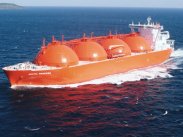
This also requires that the energy is first converted into a fuel. For example, liquid hydrogen might be chosen. If the plant uses the electrical energy to generate liquid hydrogen at about 75% efficiency, it would create about 3,000 cubic metres of liquid hydrogen a day with an energy capacity of 8,640 megawatt-hours, an average rate of about 360 megawatts. A single ship to carry 30 days production would need to store about 100,000 cubic metres. This is rather smaller that the size of existing large tankers for liquid natural gas (see photo). The ship could transport this load over, say, 5,000 km of sea in less than 10 days at 25 km/hour, so a single ship costing, say, £100 million should be able to transport the total output of the solar plant, with one delivery every 30 days. Conclusion The very ambitious Desertec initiative looks like a serious attempt to use solar power in a significant way for Europe. The transport of energy as a fuel by ship also appears to be promising at present. The capital costs are much lower. It is also more flexible, can handle longer distances, is easier to introduce and is less likely to be disrupted by sabotage or political actions. However the technology to carry liquid hydrogen by ship is still under development. Intermittent Energy Sources and Energy Storage In this section we discuss the problems and possibilities for dealing with the output from renewable energy sources, some of which (most notably wind and solar) are intermittent. Part of the solution involves storing energy on a large scale. This can help in matching these unpredictable energy sources with the rapidly varying electricity load, and to provide energy when renewable sources cannot supply enough. Energy storage on a domestic scale is discussed on our domestic generation page. Handling intermittent energy sources Some of the most promising sources of green energy do not collect power continuously. Those dependent on the sun operate only during the day, though concentrated solar power can be extended by storing heated fluids. They are also affected by cloud cover and the season. Tidal power, as in the proposed Severn Estuary scheme, can generate a significant proportion of the energy needs of the country, but the supply is not continuous. Wind power can be averaged with turbines in different locations, but there are extended periods when the wind is light across the country. How can we use such energy sources as a major part of our electricity supply? Later on we discuss some options for storing energy on a fairly large scale. However, such solutions are most appropriate for smoothing temporary variations in output. Indeed, some are already coming into use to help the electricity system adjust to sudden changes in demand. A much bigger challenge is to compensate for major changes in output, for example at high or low tide with a tidal system, when there is a prolonged period of low wind, or when cloud covers the country, as these cases would require storage systems comparable in size to the energy source being supported. If we wish to obtain a large part (e.g. more than 30%) of our energy from clean but intermittent energy sources, then we have to find ways to handle large-scale variations in output. Some of the main strategies for maintaining supplies are likely to be as follows:
The decisions to start generating from additional conventional plant or to stop supplying heavy industrial users need not be made instantly. The distributed nature of green energy sources means that variations in output will be somewhat smoothed over a short time period, and it is possible to predict the energy available for a reasonable time ahead using weather forecasting. Smaller fluctuations can be handled using the energy storage techniques described below. Energy storage At present, pumped-storage hydropower provides 99% of the large-scale storage for electricity generation world-wide; in the UK this is done in Wales and Scotland. However, the total amount energy that can be stored is currently very small. Pumped storage is a well-tested, low-technology solution and could be very usefully expanded, but it can only provide a small fraction of the huge amount of storage needed. Three new possibilities receiving much of the attention are compressed air, batteries and flywheels, but other interesting ideas are also being suggested. Compressed air Renewable electricity would be used to compress air to high pressure. The air would then be stored until needed, and released through a turbine to generate electricity. At present a number of systems are being developed that would each provide power levels of several hundred megawatts for several hours. Some of these systems store the huge volumes of compressed air in abandoned mines or salt caverns. Other approaches use large high-pressure tanks, but their available volume is a severe limitation. A proposal (from Nottingham University) recently in the news would use huge, slowly rotating wind turbines with pistons inside their blades to compress the air, then store it in flexible, relatively inexpensive plastic bags on the bottoms of lakes or oceans in deep water close to a coast. The advantage is that constant high pressure is provided by the deep water as the bags are filled and emptied, and without needing high-pressure tanks. Although such air-compressing wind turbines don't exist yet, the underwater storage and compressed-air generation could be tested and developed using other compression methods. The main obstacles these compressed air schemes have to overcome are the overall energy efficiency of the compression and electricity generation, the many logistic and technical problems of using mines or underwater sites, and safety considerations of using high-pressure storage vessels and pipes. Batteries Batteries store electricity in the form of chemical energy. In addition to familiar small-scale applications such as the lead-acid batteries in cars or the small batteries used in electric and electronic gadgets, there is also considerable work to develop batteries for large-scale storage. The main problems to overcome are that batteries are currently expensive, and have limited lifespans. Lithium-ion batteries are a popular type because they store a lot of electricity in a small volume and they hold their charge for a long time. They will be used in most types of electric cars appearing soon, and they are also under consideration for utility-scale applications. Another possibility is sodium-sulphur batteries, which are being developed as a possible replacement for pumped-storage hydropower in Japan. Batteries providing up to 7 megawatts are being developed as temporary short-term storage to reduce "congestion" on electric transmission lines. Vanadium redox batteries are beginning to be used in several locations to smooth the output of wind turbines. Recent installations can store up to 12 megawatt-hours of energy. Lead-carbon batteries are being developed as improved versions of existing lead-acid batteries, especially in stationary situations where weight is not an important issue. They could be cheaper than lithium-ion batteries because they would use everyday materials. Flywheels Flywheels can quickly convert electricity into the kinetic energy of a heavy, rotating disc and back again at high efficiency. The disc is accelerated by an electric motor which acts as a generator when reversed, slowing down the disc and producing electricity. A big advantage is that the electricity can be made available very quickly. Flywheels can store the energy for a long time if friction is kept low, for example by using magnetic bearings and keeping the flywheel in a vacuum. To store a lot of energy, the flywheel must be very heavy and rotate very quickly, and this requires very strong materials. At present, flywheel storage is often used to provide uninterrupted electricity for short periods, such as the interval between a power cut and the start-up of a backup diesel generator at large data centres. They are beginning to be used to optimise mixed use of wind power and diesel generators for small, isolated electricity grids, where their smoothing action allows a larger overall contribution by the wind generators. At present, commercially available flywheel systems can provide very short-term power of more than 10 megawatts, or store more than 100 kilowatt-hours of energy. Gravel?An unusual proposal to use cheap, common materials to store renewable energy, for example from a wind farm, is being pursued by a small UK company called Isentropic. Their system uses two silos full of gravel with a combined heat pump/heat engine between them, as in the diagram. 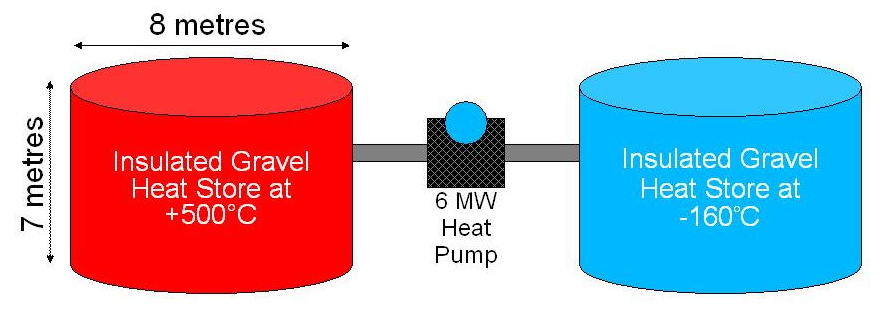
Electricity from the renewable source runs the heat pump to heat and compress argon gas, which then goes to one of the silos and heats the gravel to about 500°C. The exiting argon gas is at ambient temperature but remains compressed. It is then sent to the second silo, where it expands back to atmospheric pressure – this cools the gas and the gravel in the second silo to about –160°C. (This works like a fridge.) The temperature difference between the two silos effectively stores the electrical energy used to compress and heat the gas. It is claimed that a well-insulated silo can maintain its temperature for very long periods of time. Will it work? The temperature difference seems very large for a single-pass cycle, and the gravel will have to be kept out of the mechanical parts. Isentropic is developing a pilot plant, shown in the diagram, to store 16 megawatt-hours of energy. The largest pumped-storage hydropower facility in the world, in Virginia, USA, has a capacity of 30 gigawatt-hours (2000 times the pilot gravel system). Its two lakes cover 820 acres of land; Isentropic claims their gravel system would only need to cover a few acres to store the same amount of energy. Other possibilities Another possible storage method uses so-called supercapacitors, which store electric charge at much higher densities than the small capacitors used in electronic devices. They can discharge their energy more rapidly than batteries, and have much longer cycling lifetimes. Their very serious limitation at present is that the stored energy density is less than a tenth that of batteries, and utility-scale devices are still a long way off. Cars and other vehicles need mobile energy sources to replace petrol and diesel. Renewable electricity can be used to charge batteries that drive electric motors, and such electric cars will soon be widely available. A possible alternative is to use renewable energy to produce hydrogen, which can be used either by burning it directly or, probably better, in electricity-generating fuel cells. Since it takes energy to produce the hydrogen, it is best regarded as an energy storage medium rather than a fuel like oil. If the much-publicised "hydrogen economy" ever materialises, hydrogen could also be used in many other applications. All this is discussed further on our hydrogen page. Summary At present it is not clear which of these possibilities will be widely adopted, since more research and development is needed. It is likely that different methods will turn out to be useful for different requirements, so there may be a few winners. A useful article with more details and links is available here, and there is also an interesting Wikipedia article on grid-scale energy storage. In order to allow large-scale use of fossil fuels to continue, at least in the short-term, various schemes for capturing carbon dioxide and storing it indefinitely rather than releasing it to the atmosphere are being worked on. This is variously called carbon capture and storage (CCS) or carbon sequestration. The main alternatives being considered are: 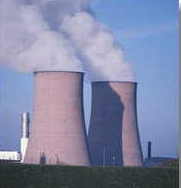
Biological: Increasing the growth of plants to trap atmospheric carbon dioxide. The storage can be long term if the plant material is retained in the soil. Note that this is really an "offset" scheme, rather than a capture scheme for the carbon dioxide that is actually generated. Geological: Storing the carbon dioxide underground, for example in the reservoirs where natural gas or oil has been extracted. Progress on storing carbon dioxide geologically has been painfully slow, with very few projects actually being implemented. The costs and difficulties look worse than was thought. Oceanic: Storing compressed and liquid carbon dioxide at the bottom of the oceans, where it should be maintained in a liquid state by the local pressure and temperature. Mineralisation: Converting it to a solid form such as a carbonate, which can then be used as a building material. The problems include: evaluating whether the storage process itself generates so much extra carbon dioxide that the benefits are cancelled out, making sure the carbon dioxide will not escape from the storage, and solving various other technical challenges. |
 |
If you have any comments or queries about this website please contact the
webmaster. |
© Blewbury Energy Initiative 2015 |